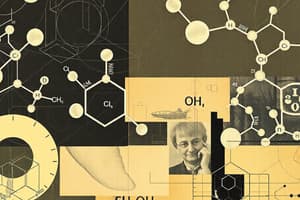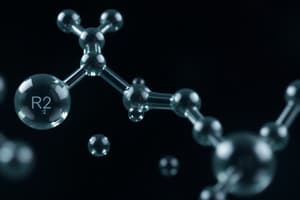Podcast
Questions and Answers
Consider a scenario where a chemist synthesizes a compound and obtains a lower-than-expected yield. Which factor would LEAST likely contribute to a percent yield that is less than 100%?
Consider a scenario where a chemist synthesizes a compound and obtains a lower-than-expected yield. Which factor would LEAST likely contribute to a percent yield that is less than 100%?
- Loss of product during purification.
- Use of a catalyst in excess of its optimal concentration. (correct)
- Presence of side reactions leading to byproducts.
- Incomplete reaction of the reactants.
A gaseous compound is analyzed and found to contain 30.4% nitrogen and 69.6% oxygen by mass. If the molar mass of the compound is determined to be 92 g/mol, what is its molecular formula?
A gaseous compound is analyzed and found to contain 30.4% nitrogen and 69.6% oxygen by mass. If the molar mass of the compound is determined to be 92 g/mol, what is its molecular formula?
- N$_2$O$_4$ (correct)
- NO$_2$
- NO
- N$_2$O
An organic chemist performs a reaction and isolates a product with an actual yield of 15.0 grams. If the theoretical yield was 20.0 grams, what is the percent yield of the reaction?
An organic chemist performs a reaction and isolates a product with an actual yield of 15.0 grams. If the theoretical yield was 20.0 grams, what is the percent yield of the reaction?
- 80.0%
- 66.7%
- 75.0% (correct)
- 133.3%
In a specific chemical reaction, it is found that increasing the concentration of a reactant beyond a certain point does not increase the rate of the reaction. This suggests that:
In a specific chemical reaction, it is found that increasing the concentration of a reactant beyond a certain point does not increase the rate of the reaction. This suggests that:
If 10.0 grams of both reactants, A and B, are mixed and react to form product C, with the balanced equation A + B → C, and the molar mass of A is less than the molar mass of B, then which of the following statements is true?
If 10.0 grams of both reactants, A and B, are mixed and react to form product C, with the balanced equation A + B → C, and the molar mass of A is less than the molar mass of B, then which of the following statements is true?
Which of the following statements is correct regarding isotopes of the same element?
Which of the following statements is correct regarding isotopes of the same element?
In mass spectrometry, the peak height for an isotope is directly proportional to its:
In mass spectrometry, the peak height for an isotope is directly proportional to its:
Two different elements, X and Y, have the same mass number. Which of the following statements must be true?
Two different elements, X and Y, have the same mass number. Which of the following statements must be true?
Element X has two stable isotopes: $^{10}$X and $^{11}$X. If the average atomic mass of X is 10.8 amu, which isotope is more abundant?
Element X has two stable isotopes: $^{10}$X and $^{11}$X. If the average atomic mass of X is 10.8 amu, which isotope is more abundant?
A chemist needs to prepare a solution with a specific molarity of a certain compound. However, the available compound is only 95% pure. How should the chemist adjust the mass of the compound needed?
A chemist needs to prepare a solution with a specific molarity of a certain compound. However, the available compound is only 95% pure. How should the chemist adjust the mass of the compound needed?
Phosphorus pentachloride (PCl$_5$) decomposes in the gas phase to form phosphorus trichloride (PCl$_3$) and chlorine (Cl$_2$). If the initial concentration of PCl$_5$ is 0.5 M and at equilibrium the concentration of Cl$_2$ is 0.2 M, what is the equilibrium constant (K) for the reaction?
Phosphorus pentachloride (PCl$_5$) decomposes in the gas phase to form phosphorus trichloride (PCl$_3$) and chlorine (Cl$_2$). If the initial concentration of PCl$_5$ is 0.5 M and at equilibrium the concentration of Cl$_2$ is 0.2 M, what is the equilibrium constant (K) for the reaction?
When determining the limiting reactant in a chemical reaction, which of the following steps is crucial?
When determining the limiting reactant in a chemical reaction, which of the following steps is crucial?
A reaction produces a mixture of products A and B. After careful separation, the recovered amount of A is significantly less than the theoretical yield. What is the LEAST likely explanation of this phenomenon?
A reaction produces a mixture of products A and B. After careful separation, the recovered amount of A is significantly less than the theoretical yield. What is the LEAST likely explanation of this phenomenon?
A compound has the empirical formula C$_2$H$_5$O. If its molar mass is determined to be 90 g/mol, what is its molecular formula?
A compound has the empirical formula C$_2$H$_5$O. If its molar mass is determined to be 90 g/mol, what is its molecular formula?
In the reaction 2A + B → C, if the molar mass of A is half that of B, and you start with equal masses of A and B, which reactant is most likely the limiting reactant?
In the reaction 2A + B → C, if the molar mass of A is half that of B, and you start with equal masses of A and B, which reactant is most likely the limiting reactant?
Consider a reaction where the theoretical yield of a product is 25.0 grams. If the percent yield of the reaction is 80.0%, how much of the product was actually obtained?
Consider a reaction where the theoretical yield of a product is 25.0 grams. If the percent yield of the reaction is 80.0%, how much of the product was actually obtained?
The atomic mass of copper is 63.55 amu. Copper has two naturally occurring isotopes, $^{63}$Cu and $^{65}$Cu. If the mass of $^{63}$Cu is 62.93 amu, and the mass of $^{65}$Cu is 64.93 amu, what is the approximate percent abundance of $^{63}$Cu?
The atomic mass of copper is 63.55 amu. Copper has two naturally occurring isotopes, $^{63}$Cu and $^{65}$Cu. If the mass of $^{63}$Cu is 62.93 amu, and the mass of $^{65}$Cu is 64.93 amu, what is the approximate percent abundance of $^{63}$Cu?
Two elements, X and Y, form a compound with the formula X$_2$Y$_3$. If 0.2 mole of X weighs 5.6 g and 0.1 mole of Y weighs 1.6 g, what is the total mass of 1 mole of X$_2$Y$_3$?
Two elements, X and Y, form a compound with the formula X$_2$Y$_3$. If 0.2 mole of X weighs 5.6 g and 0.1 mole of Y weighs 1.6 g, what is the total mass of 1 mole of X$_2$Y$_3$?
A chemist mixes 4.0 g of hydrogen gas with 32.0 g of oxygen gas and ignites the mixture. Water is formed as a result. If the reaction goes to completion, how many grams of water are produced?
A chemist mixes 4.0 g of hydrogen gas with 32.0 g of oxygen gas and ignites the mixture. Water is formed as a result. If the reaction goes to completion, how many grams of water are produced?
What volume of $0.200 M$ $KCl$ solution is required to react completely with $25.0 mL$ of $0.200 M$ $AgNO_3$ solution? (Reaction: $AgNO_3(aq) + KCl(aq)
ightarrow AgCl(s) + KNO_3(aq)$)
What volume of $0.200 M$ $KCl$ solution is required to react completely with $25.0 mL$ of $0.200 M$ $AgNO_3$ solution? (Reaction: $AgNO_3(aq) + KCl(aq) ightarrow AgCl(s) + KNO_3(aq)$)
Flashcards
Atomic Mass
Atomic Mass
The mass of one atom of an element, measured in atomic mass units (amu).
Molecular Mass
Molecular Mass
The sum of the atomic masses of all atoms in a molecule.
Molar Mass
Molar Mass
The mass of one mole of a substance, numerically equal to the atomic or molecular mass in grams.
Mole
Mole
Signup and view all the flashcards
Stoichiometry
Stoichiometry
Signup and view all the flashcards
Limiting Reactant
Limiting Reactant
Signup and view all the flashcards
Percent Yield
Percent Yield
Signup and view all the flashcards
Atomic Number (Z)
Atomic Number (Z)
Signup and view all the flashcards
Mass Number (A)
Mass Number (A)
Signup and view all the flashcards
Isotopes
Isotopes
Signup and view all the flashcards
Isobars
Isobars
Signup and view all the flashcards
Study Notes
- Chemistry is the study of matter and its properties as well as how matter changes
Atomic Mass
- Defined as the mass of an atom
- Measured in atomic mass units (amu) or Daltons (Da)
- Approximately equal to the number of protons plus neutrons in the nucleus
Molecular Mass
- The sum of the atomic masses of all atoms in a molecule
- Calculated by adding up the atomic masses of each element multiplied by its subscript in the chemical formula
Molar Mass
- The mass of one mole of a substance
- Numerically equal to the atomic or molecular mass in grams per mole (g/mol)
- Can be determined by adding the atomic masses of the elements in the chemical formula, expressed in grams
Mole Concept
- A mole (mol) is the SI unit for the amount of a substance
- One mole contains exactly 6.02214076 × 10^23 elementary entities (Avogadro's number)
- These entities can be atoms, molecules, ions, or other specified particles
- Provides a bridge between the atomic scale and the macroscopic scale
Stoichiometry
- Deals with the quantitative relationships between reactants and products in chemical reactions
- Based on the law of conservation of mass, which states that matter cannot be created or destroyed
- Uses balanced chemical equations to determine the mole ratios of reactants and products
- Mole ratios are used to calculate the amounts of reactants needed or products formed in a reaction
Stoichiometric Calculations
- Involve converting given information (e.g., mass, volume, or number of moles of a reactant) into the desired information (e.g., mass or number of moles of a product) using the mole ratio from the balanced chemical equation
Limiting Reactant
- The reactant that is completely consumed in a chemical reaction
- Determines the maximum amount of product that can be formed
- The other reactants are present in excess
Percent Yield
- The actual yield of a product expressed as a percentage of the theoretical yield
- Actual yield is the amount of product obtained from a reaction
- Theoretical yield is the maximum amount of product that can be formed based on stoichiometric calculations
- % Yield = (Actual Yield / Theoretical Yield) * 100
Atomic Number
- The number of protons in the nucleus of an atom
- Defines the identity of an element
- Denoted by the symbol Z
- Atoms of the same element have the same number of protons
Mass Number
- The total number of protons and neutrons in the nucleus of an atom
- Denoted by the symbol A
- Number of neutrons = Mass number - Atomic number (N = A - Z)
Isotopes
- Atoms of the same element that have the same number of protons but different numbers of neutrons
- Have the same atomic number but different mass numbers
- Exhibit similar chemical properties
- Some isotopes are radioactive (radioisotopes)
- The abundance of isotopes is the percentage of atoms of a natural sample of the pure element represented by a particular isotope
Isobars
- Atoms of different elements that have the same mass number but different atomic numbers
- Have different numbers of protons and neutrons, but their sum is the same
- Different chemical properties due to different numbers of protons
Studying That Suits You
Use AI to generate personalized quizzes and flashcards to suit your learning preferences.





